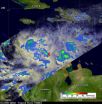(Press-News.org) The Tropical Rainfall Measuring Mission (TRMM) satellite traveled over Tomas twice on Tuesday, Nov. 2. The second time was at 2005 UTC (4:05 p.m. EDT) when it was still classified as a tropical storm. During TRMM's second overpass, Tomas' center of circulation wasn't evident. Today, Nov. 3 that center is reforming.
During the morning hours on Nov. 3, an Air Force hurricane hunter aircraft found no tropical storm force winds so Tomas was downgraded by the National Hurricane Center to a tropical depression.
At 2 p.m. EDT on Nov. 3, Tomas was undergoing some changes, and its center was re-forming farther to the northeast from where it was before. The center is now located near 14.8 North and 75.0 West, about 245 miles south-southeast of Kingston, Jamaica and 315 miles southwest of Port Au Prince, Haiti. Maximum sustained winds were still at 35 mph, making Tomas still a depression. It was moving to the north-northwest near 7 mph and had a minimum central pressure of 1006 millibars. A turn toward the north and north-northeast is expected over the next 48 hours.
A Tropical Storm Watch has now been posted for Jamaica, and Haiti, the Dominican Republic, southeastern Cuba, the southeastern Bahamas and Turks and Caicos Islands should watch Tomas' track.
Tomas is expected to produce total rain accumulations of 5 to 10 inches over much of Haiti with possible isolated maximum amounts of 15 inches.
Tomas is now predicted to strengthen into a tropical storm and not reach hurricane strength. An upper level trough is predicted to steer a stronger Tomas through the Windward Passage between Cuba and Haiti by Friday.
INFORMATION:
NASA's TRMM satellite sees Tomas' power fluctuate
2010-11-04
ELSE PRESS RELEASES FROM THIS DATE:
What will Webb see? Supercomputer models yield sneak previews
2010-11-04
VIDEO:
Two spiral galaxies undergo a protracted crash lasting two billion years, eventually merging into a single elliptical galaxy.
Click here for more information.
As scientists and engineers work to make NASA's James Webb Space Telescope a reality, they find themselves wondering what new sights the largest space-based observatory ever constructed will reveal. With Webb, astronomers aim to catch planets in the making and identify the universe's first stars and galaxies, yet ...
Prostate cancer's multiple personalities revealed
2010-11-04
NEW YORK (Nov. 3, 2010) -- Scientists at Weill Cornell Medical College have taken an important step toward a better understanding of prostate cancer by uncovering evidence that it is not one disease, as previously believed, but rather several factors which can be measured and, in the future, destroyed by targeted therapy.
The research team led by of Dr. Mark A. Rubin, the Homer T. Hirst Professor of Oncology in Pathology and vice chair for experimental pathology at Weill Cornell Medical College, identified secondary mutations that cause some types of prostate cancer ...
Half of those travelling internationally not aware of potential health risks
2010-11-04
More than 30 million people in the United States travel to resource-limited areas of the world each year. This global mobility may contribute to the spread of infectious diseases – such as influenza, measles, and meningitis – and may also put individual travelers at risk for malaria, typhoid, dengue fever and hepatitis. Despite these potential risks, a recent study conducted by the Division of Infectious Diseases at Massachusetts General Hospital (MGH) and published in the Journal of Travel Medicine found that 46 percent of travelers to resource-limited countries did ...
New lymphoma therapy may be more effective with fewer side effects
2010-11-04
NEW YORK (Nov. 3, 2010) -- Diffuse large B-cell lymphoma (DLBCL) is a type of aggressive non-Hodgkin's lymphoma that accounts for approximately 40 percent of lymphomas among adults. If left untreated, it is fatal. The existing treatments have a cure rate that is slightly over 50 percent but destroy healthy cells along with the cancer cells.
Researchers at Weill Cornell Medical College have found a combination therapy that is more effective than traditional treatments and is able to kill the cancer cells without harm to surrounding tissues. In a paper published in the ...
Medication adherence improves blood pressure control in chronic kidney disease
2010-11-04
CINCINNATI—Researchers at the University of Cincinnati (UC) and the Cincinnati Veterans Affairs (VA) Medical Center have found that about one-third of chronic kidney disease patients who are prescribed therapies for high blood pressure do not often adhere to treatments.
This report was published in the Nov. 2 online edition of the American Journal of Nephrology.
The study, led by researchers at UC and the Cincinnati VA, showed that treatment of hypertension in patients with chronic kidney disease continues to be a challenge in their care and that by simply improving ...
New research shows disparities in hospice enrollment are not likely related to access
2010-11-04
Researchers at Mount Sinai School of Medicine have found that 98 percent of the U.S. population lives in communities within 60 minutes of a hospice provider, suggesting that disparities in use of hospice are not likely due to a lack of access to a hospice provider. The results are published in the current issue of the Journal of Palliative Medicine.
"Despite a significant increase in the availability of hospice services during the past decade, the majority of Americans die without hospice care," said Melissa D.A. Carlson, PhD, Assistant Professor of Geriatrics and Palliative ...
Cell membranes behave like cornstarch and water
2010-11-04
VIDEO:
Video opens with footage of a common cornstarch and water experiment. Ian Oberst, a visiting student from Portland Community College who participated in the University of Oregon's UCORE program for...
Click here for more information.
Mix two parts cornstarch and one part water. Swirl your fingers in it slowly and the mixture is a smoothly flowing liquid. Punch it quickly with your fist and you meet a rubbery solid -- so solid you can jump up and down on a vat of it.
It ...
Water flowing through ice sheets accelerates warming, could speed up ice flow
2010-11-04
Melt water flowing through ice sheets via crevasses, fractures and large drains called moulins can carry warmth into ice sheet interiors, greatly accelerating the thermal response of an ice sheet to climate change, according to a new study involving the University of Colorado at Boulder.
The new study showed ice sheets like the Greenland Ice Sheet can respond to such warming on the order of decades rather than the centuries projected by conventional thermal models. Ice flows more readily as it warms, so a warming climate can increase ice flows on ice sheets much faster ...
Cosmic curiosity reveals ghostly glow of dead quasar
2010-11-04
New Haven, Conn.—While sorting through hundreds of galaxy images as part of the Galaxy Zoo citizen science project two years ago, Dutch schoolteacher and volunteer astronomer Hanny van Arkel stumbled upon a strange-looking object that baffled professional astronomers. Two years later, a team led by Yale University researchers has discovered that the unique object represents a snapshot in time that reveals surprising clues about the life cycle of black holes.
In a new study, the team has confirmed that the unusual object, known as Hanny's Voorwerp (Hanny's "object" in ...
Positive psychological changes from meditation training linked to cellular health
2010-11-04
Positive psychological changes that occur during meditation training are associated with greater telomerase activity, according to researchers at the University of California, Davis, and the University of California, San Francisco. The study is the first to link positive well-being to higher telomerase, an enzyme important for the long-term health of cells in the body.
The effect appears to be attributable to psychological changes that increase a person's ability to cope with stress and maintain feelings of well-being.
"We have found that meditation promotes positive ...


